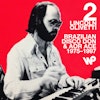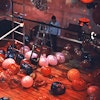On a snowy winter’s day just after Valentine’s, I met Nicky Siano in a deserted bumper car arcade in Coney Island. “Isn’t it amazing!” the legendary DJ enthused as he pointed out gigantic wooden structures lining the walls, which on closer inspection turned out to be massive cabinets built to channel bass frequencies. Lurking in each corner, past a pile-up of dormant bumper buggies, were eight-foot tall speaker stacks. Suspended over the middle aisle that cars would circle in summer were four bullet-tweeter arrays, an invention devised by David Mancuso to deliver a glistening high-end sheen to audio at the Loft. “This is the same type of sound system used in the [Paradise] Garage, the same as in Studio 54,” Siano says, “built by Richard Long.”
How the legendary sound engineer came to outfit this Coney Island staple with its over the top system—a Lamborghini engine in a Chevy Suburban body—is unknown. But as far back as the mid-’70s, Siano and another Brooklyn kid named Larry Philpot used to come out to ride the bumper cars and listen to the incredible sound. Siano was a mentor of sorts to Philpot. Although they were nearly the same age, Siano was already making waves in the burgeoning discotheque scene with his preternaturally skilled DJing and flamboyant personality. Philpot soaked up everything he could from the more experienced DJ and incorporated much of what he learned when he began using his mother’s maiden name, Levan, and became one of the most celebrated DJs in history.
But back in the early ’70s, the future Larry Levan and his friend Frankie Knuckles were just kids blowing up balloons and manning the refreshments table at a unique private club called The Gallery. Founded by Siano and his older brother Joe, the Gallery was inspired by Mancuso’s Loft but pushed the hedonistic aesthetic much farther. The joyous, ecstatic experience that the Gallery aimed for was evident in every aspect of the club, from the top notch, custom built sound system to the revolutionary lighting rigs to the notorious acid-spiked punch. The Gallery was the first place to have three turntables (“I had the vision of playing a sound effect as I crossfaded records,” says Siano), it was the first to have “crossover” EQs for extreme isolation of frequencies, it was the first to have gigantic acoustic cabinets to amplify bass sounds.
The Gallery clientele was extremely diverse. Racially and sexually, if you were down for the experience the Gallery was there for you—as long as you were a member or were accompanied by one. “The fact that we were private fostered a camaraderie that didn’t exist in regular dance places,” Siano recalls. “We definitely had a much more friendly and inclusive feel.”
A Gallery devotee captured on a 1977 student film made at the club backs this up: “I have thousands of acquaintances in this place… It’s like a world underneath a world, an underground place to get high and party all night.” And then there was the music.
Siano was not just an expert at beat-matching, using the rudimentary pitch controls of his Thorens TD-125 turntables (maximum range: +/-6%), but he also was adept at matching sounds and moods, thereby connecting records that other DJs might’ve never attempted to put together. His energy and intensity was renowned. “Nicky works it,” the same partier declared. “Nicky works it til he’s dead, til he can’t take it no more! And he takes it! He plays! I have never seen anyone work it like Nicky can.” Reflecting back on those days, Siano confirms that he kept the energy in the room at a elevated level for an unusually extended period of time, “peaking the crowd longer than most and just becoming part of the party rather than playing to it. I was in it!”
Actual audio documentation of Siano’s DJ sets at the Gallery has been frustratingly scarce, with latter-day fans making do with playlists and their imaginations. Recently, however, as an exclusive gift for Wax Poetics, Nicky Siano has dusted off a recording from October, 1976 at the Gallery and converted it to digital format for the first time. The half-hour snippet of the night is remarkable in the breadth it covers over the course of its abbreviated length, amply demonstrating skills that would be picked up by a future generation of DJs (back-to-back doubles to extend intros, quick-mixing between different songs while keeping the mood and key intact, flawless integration of obscure non-hits to elevate them to anthem status, etc.). Listeners can only imagine the effect when the music was amplified over a state of the art system and intensified by a light show regulated by custom built foot pedals in the DJ booth.






